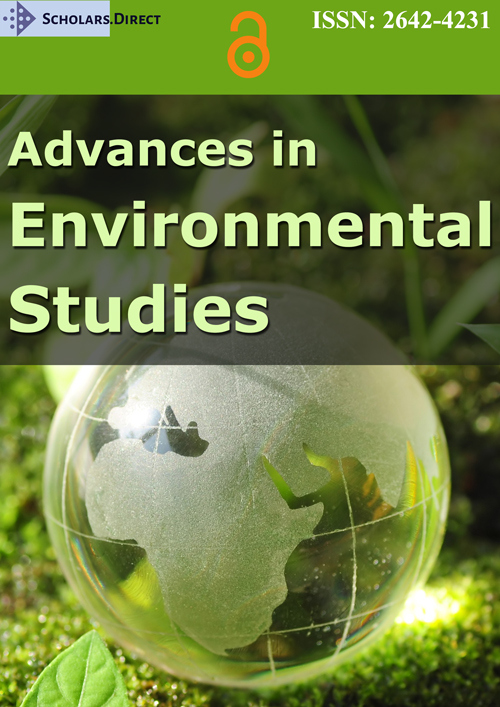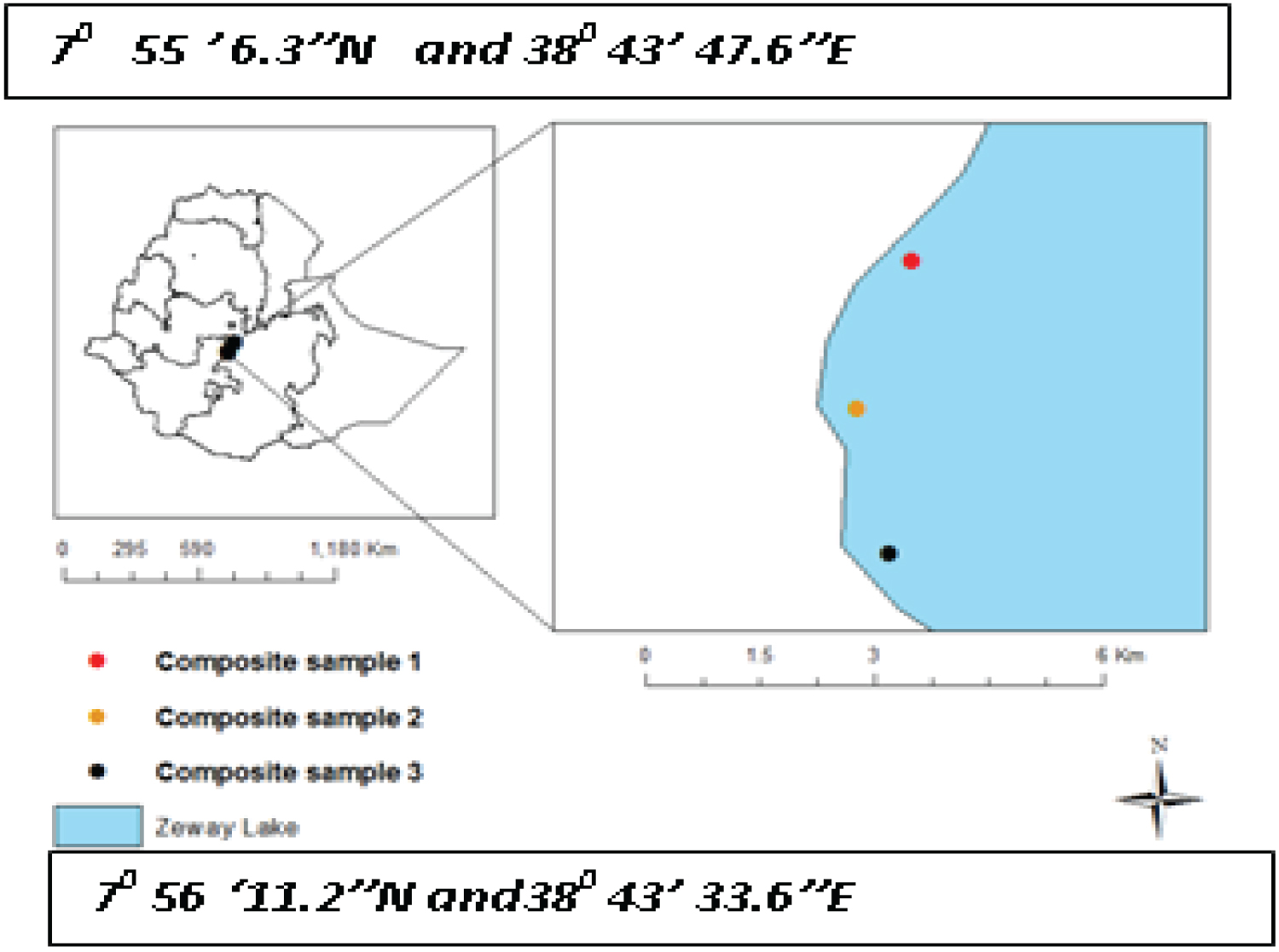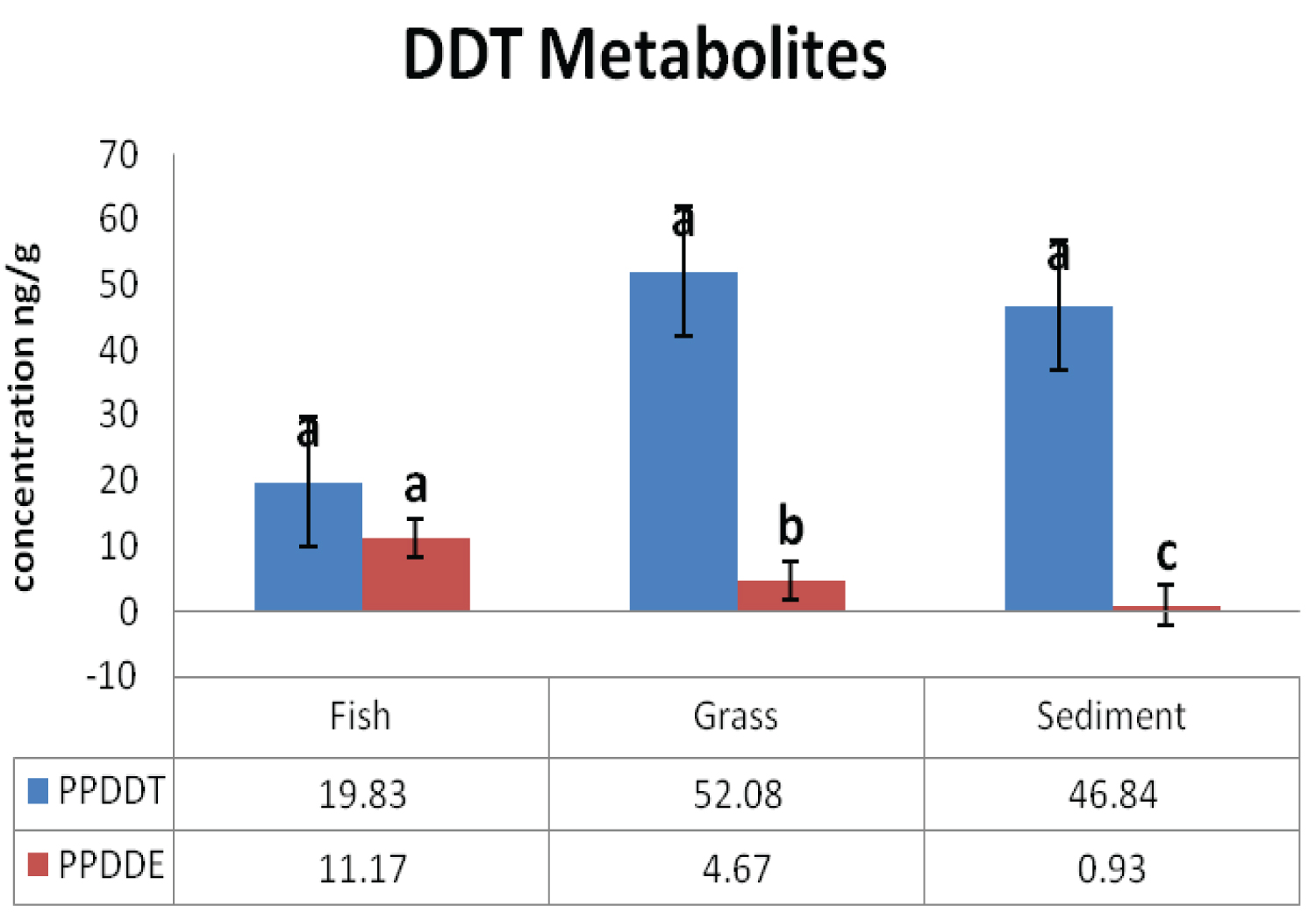Detection of Organochlorine Pesticide Residues in Lake Ziway and Health Risk Assessment
Abstract
Organochlorine pesticides (OCPs) are chlorinated hydrocarbons extensively used for agriculture pest control and mosquito control from 1940s to 1960s. The use of OCPs for agricultural purpose was banned in many countries including Ethiopia. However, studies show that small scale farm holders in the central rift valley of Ethiopia use cocktail of pesticides including banned OCPs. This study was intended to detect the status of (OCP) residues in Ziway Lake, Oromia region of Ethiopia. For this study three commercially important fish species, sediment and succulent grass samples were randomly collected in replicate. The samples were extracted using USEPA (354 °C) method and the analysis was done using USEPA (8081) method. The health risk assessment was calculated based on USEPA (1996) guidelines while the data analysis was done using SAS 93.2 statistical software. The Laboratory result revealed that Dichlorodiphenyltrichloroethane (DDT) metabolites, (PP'DDT and PP'DDE) were detected in all the three sample types. Accordingly, mean concentration of PP'DDT and PP'DDE detected in the three sample types were, 52.08 and 4.67 ng/g in succulent grass, 46.84 and 0.93 ng/g in sediment and 19.83 and 11.17 ng/g in fish samples. Among the three fish species tested, the maximum DDT metabolite residue detected was in Ciprinu scarpio fish spices (35.65 ng/g) while the minimum was in Carassius carassius fish spices (27.05 ng/g). People who regularly consume fish from the lake above estimated mean Ethiopian daily consumption (0.027 kg day-1), level are exposed to DDT while that those consume all species of fish from Lake below estimated mean , does not exposed to health problem . However, the low PP'DDE /PP'DDT ratio in sediment and succulent grass sample indicates that there is a recent pollution of the lake by DDT. Thus, Eco-system clearance from obsolete pesticides and control of illegal band organochlorine pesticide movement has to be given due attention.
Keywords
Organochlorine pesticide, Fish, Bio-accumulation, Health risk
Abbreviations
OCPs: Organochlorine Pesticides; USEPA: United states Environmental protection Agency; pp'DDT: p,p'-Dichlorodiphenyltrichloroethane (DDT); pp'-DDE: Dichloro diphenyl dichloroethylene; PSD: Sediment Particle size distribution; FAO: Food and Agricultural organization; ROCP: Residue organochlorine pesticides; HI: Hazard indices; LED: The lifetime exposure dose; RfD: Reference dose; EEFRI: Ethiopian Environment and Forest research institute
Introduction
Organochlorine pesticides (OCPs) are chlorinated hydrocarbons. These chemicals had been used extensively in the agriculture sector to control pests and in the health sector to control mosquito commencing 1940's to 1960's [1].
The legally-binding agreement between states was made and Stockholm convention (SC) was signed in 2001 and entered into force in 2004 by many countries with the overall objective of protecting human health and the environment from POPs. Ethiopia signed this agreement on 17 May 2002 and ratified the instrument on 2 July 2002. As neurotoxicants, Organochlorine pesticides were banned in many countries including Ethiopia who ratified Stockholm convention. However, DDT has been used for the purpose of disease vector control (malaria) in the country until 2011. These resulted in accumulation of obsolete (DDT) pesticide, poor storage facility, luck of destruction incinerators are among the problems facing the country. (UNEP-POPS-NIP-Ethiopia), [2] current inventory report on obsolete pesticide stores by Ministry of Environment Forest and Climate change shows reported significant quantity of obsolete pesticide stores [3]. Volatilization of these Chemicals from poorly managed obsolete pesticide stores and contaminated sites are major Environmental challenge for the country. They can contaminate the biotic and abiotic environment through, erosion from sprayed field and through dry deposition from the atmosphere.
Studies show that legally banned DDT & endosulfan were in use by small scale vegetable farmers and the availability of these smuggled chemicals in shops around central rift valley. Amare and [4] other researchers reported the use of DDT and detected significant quantity of its residue on freshly consumed khat "Catha edulis" [5,6].
Basic POPs report on core biotic matrices (5th round human milk survey) under Global monitoring of POPs reflects this reality. The report shows that significant concentration of Organochlorine pesticide residues especially DDT and its metabolites were detected in pooled maternal milk sample collected from different parts of Ethiopia.
Other study tried to address the impact of DDT metabolites on Ziway lake ecosystem. On the study significant concentrations of DDT and its metabolites in four fish species (Clariasgariepinus, Oreochromisniloticus, Tilapia zillii, and Carassius auratus) detected [7].
The former studies didn't included the currently most important fish species Ciprinuscarpio and Carassius carassius and also did not included the Organochlorine pesticide residue in succulent grass and sediments which were identified as food for the fishes. This study was planned to fill these gap with general objective to detect Organochlorine Pesticide residue in Ziway Lake ecosystem.
Materials and Methods
Sampling site description
The study area, Lake Ziway, is located in the geographical between 7° 52' to 8° 8' N and 38° 40' to 38° 56' E and has an altitude of 1636 m.a.s.l. The Lake is the fourth largest Lake in Ethiopia with an open water area of 434 km2. It is the shallowest of the rift valley lakes with maximum and mean depth of 8.95 m and 2.5 m, respectively [8].
Sample collection, procedure and Analysis
Three composited replicate sediments samples were collected from three different locations in the lake (Figure 1). Each sampling point was 150 meters from the margin of the lake and the diagonal distance between each sampling location was 600 meters. Also, three composited succulent grass samples in the lake were collected from the same place where the sediment samples were collected in replicate. Among Fish spices in the lake; three species were identified based on their preference by local community. These were Oreochramis nilaoticus; Ciprinuscarpio; Carassius carassius species. From each fish species ten individual fish was collected in replicate.
Sample preparation: The sediment samples were air dried and extraneous substance were removed grinded and passed through 2 mm sieve prior to analysis. The succulent tissue samples were air dried, grinded with High speed universal plant disintegrator model FW100, China the grinded sample passed through 2 mm sieve before subsequent laboratory analysis. The muscle part of freshly caught wild fish of the same species was chopped together and grinded to give one composited sample representing its species for the analysis. All the above samples were prepared in replicates.
Sample Extraction and analysis: Prior to the organochlorine extraction and analysis; sediment Particle size distribution (PSD) was analyzed by laser diffraction method using laser scattering particle size distribution analyzer while organic carbon of the sediment was determined by Weakley and Black method. The fish spices were analyzed for their lipid percentage by Soxhlet extraction method.
The Organochlorine pesticides (OCPs) in the samples were extracted by multi residue method. (EPA method 354 °C). 10 g of sample was placed into a beaker containing 10 g anhydrous sodium sulfate for sediment and succulent grass/for fish 40 g of sodium sulfate used and mixed thoroughly. The sample mixture was transferred to an extraction thimble and placed in a Soxhlet extractor. The mixture was extracted with 300 ml of acetone: n-hexane (1:1 v/v) at 6-24 hours at 4-6 cycle/hr for 20 h.
The extracts were concentrated to 2 ml using vacuum rotary evaporator and nitrogen gas bubble. Each of the raw concentrated extract was then re-dissolved in 10 ml hexane. Column containing 3 gram of activated silica gel and 3 g sodium sulfate was conditioned with hexane. The sample passed through pre-conditioned column.
The sample which was trapped in the column was eluted with 80 ml of hexane, collected and concentrated to 5 ml by blowing nitrogen gas and the elute was transferred to 10 ml volumetric flask, diluted to the mark with hexane and transferred to GC/MS auto sampler vial. The analysis was done using 7890B GC with Inlet: Split/Split- fewer modes; DB-5 ms Column and 5977B MS Detector equipped with Mass Hunter Chromatographic system.
Health risk assessment
Consumption of contaminants in food was calculated based on its concentration in the fish, and on an estimate of the fish consumption rates. The lifetime exposure dose (LED) (mg kg-1 day-1) was obtained, and the hazard indices (HI) for each age class were estimated.
LED = Residue concentrations in fish tissue sample (mg/kg) × fish consumption rate (kg/day)/Body weight (kg) HI = Estimated dose/Reference dose
The following data's were extracted from (USEPA) [9] and used for calculation;
• Hypothetical body weight (of 10 kg for children in age- class 0-1 year, 30 kg for children in age-class 1-11 years, and 70 kg for adults).
• Maximum absorption rate of 100% and a bioavailability rate of 100%
• The reference dose (RfD) of fish (µg kg-1 day-1) is 0.5
• Fish consumption rate in Ethiopia, estimated to be 0.027 kg day-1 [10].
Data validation and analysis
Sample of known concentration was processed and quantified to control the equipment performance efficiency. One way ANOVA for Randomized complete Design (SAS v. 9.2) Software was used for data analysis. Descriptive statistics were applied to analyze information obtained from the fish, succulent grass and sediment samples.
Results and Discussion
Organochlorine pesticide residues in Lake Ziway
DDT and its metabolic form (pp'DDT and pp'-DDE) are present in sediment, succulent grasses and fish muscle tissue collected from Lakes Ziway. This condition is mainly due to the persistency of these group of compounds, even though their usage is discontinued.
Among the analyzed Organochlorine Pesticides only DDT and its metabolite were detected in the three samples (Fish, Sediment and grass). Analysis of variance showed non-significant difference among the three matrices in terms of total DDT contents. However, for the degraded product of DDT (PP'DDE), there was significant difference among the three sample types (P < 0.005). The mean concentration of PP'DDE; in fish (11.17 ng/g) > succulent grass (4.67 ng/g) > sediment (0.93 ng/g) respectively (Figure 2).
The low degraded DDT Product in sediment sample can be explained by low organic carbon content (0.26; 0.4 and 0.6%), and the sandy texture of the sediment. Generally, sandy and course texture has low organochlorine chemicals affinity which makes the chemicals unavailable for microorganism for degradation.
The result shows a highly significant difference (P < 0.0001) among the fish species in terms of total DDT, PP'DDT and PP'DDE (Table 1). The sum of DDT concentration in the fish was higher in Ciprinus carpio spices (35.65 ng/g) followed by Oreochramis nilaoticus (30.29 ng/g) and Carassius carassius (27.07 ng/g). There was significant difference between Oreochramis nilaoticus and Carassius carassius and between Ciprinuscarpio and Carassius carassius. The highest PP'DDE was recorded in Ciprinus carpio followed by Oreochramis nilaoticus and Carassius carassius in that order. This can be explained by the lipid content of the fish's, the mean concentration of high PP'DDE (15.25 > 9.97 > 8.31) ng/g is directly proportional to the lipid content of the fish spices. (1.29 > 0.72 > 0.52)% Lipid.
The low PP'DDE/PP'DDT ratio of Oreochramis nilaoticus/Carassius carassius spices shows less than 50% of fresh DDT was degraded. This value is an indication of recent contamination of the fish species by fresh DDT from non point source pollution including dry deposition and wet deposition of DDT from obsolete pesticide store in the rift valley the finding agrees with the report of other researchers such as Daniel.
Health risk assessment
Comparison between lifetime estimated dose and the reference dose shows that there is no vulnerable population sub-group. Feeding fish to children would not consequently expose them to systemic toxicity. The estimated dose of DDT for adults would not exceed reference dose (with hazard index below 1) (Table 2), consumption of all species fish does not poses a health risk for a human health based on the current findings.
However, the fish fillet is still prepared and served as soup daily by the local fishermen families. For those who eat fish daily and much more than the estimated mean Ethiopian daily consumption (0.027 kg day-1), the DDT intake will thus be considerably higher [10]. Therefore, children from the fishermen families may be the most exposed and vulnerable group among the local people.
Conclusion and Recommendation
The findings of this study shows that the lake eco-system is under threat and need to be protected from pollution by obsolete pesticide. In conclusion, my results suggested the need for eco-system clearance from obsolete pesticides store to reduce which could be the case for the lake contamination. Illegal movement of band organochlorine pesticides has to be given due attention. People who live around Lake Ziway, and regularly consume fish from the lake above estimated mean Ethiopian daily consumption (0.027 kg day-1), level are exposed to DDT while that those consume all species of fish from Lake Ziway below estimated mean Ethiopian daily consumption level (0.027 kg day-1), does not exposed to health problem.
This finding can contribute the state of environment report regarding the area with respect to POPs which is a global Issue. Detail assessment on the impact of obsolete pesticides on pollinators; birds, and soil beneficiary microorganisms and farm land is needed to be investigated.
Acknowledgement
I would like to thank Prof. Gezhagne Berecha of Jimma University; for his advice and guidance during the project work and also I would like to thank Ethiopian Environment and Forest Research Institute (EEFRI) for sponsoring the laboratory analysis costs.
References
- Sisay Abebe Debela, Jian Wu, Xinyao Chen, et al. (2020) Stock status, urban public perception, and health risk assessment of obsolete pesticide in Northern Ethiopia. Environ Sci Pollut Res Int 27: 25837-25847.
- UNEP (2007) Guidance on global monitoring plan for persistent organic pollutants.
- MEFCC (2016) Persistent organic pollutants: National implementation plan update.
- Amare T, Abate A (2008) An assessment of the pesticide use, practice and hazards in the Ethiopian rift valley.
- Abdulaziz MA (2010) An assessment of possible health risks of using DDT and farmers’ perception towards toxicity of pesticides used on Khat (Catha edulis): In Haromaya Woreda, Ethiopia. Addis Ababa University, Addis Ababa, Ethiopia.
- Seblework M, Argaw A, Belay N, et al. (2017) Exposure to DDT and its metabolites from khat (Catha edulis) chewing: Consumers risk assessment from southwestern Ethiopia. Regulatory Toxicology and Pharmacology 87: 64-70.
- Ermias D, Rosseland BO, Borgstrøm R, et al. (2013) Biomagnification of DDT and its metabolites in four fish species of a tropical lake. Ecotoxicology and Environmental Safety 95: 10-18.
- Belay TM, Arthurp JM, Oosterveer P (2017) Pesticide use practices among smallholder vegetable farmers in Ethiopian Central Rift Valley. Environment, Development and Sustainability 19: 301-324.
- USEPA (1996) Integrated risk information system. USEPA, Office of Health and Environmental Assessment, Washington DC.
- FAO (2011) Fishery and aquaculture country profiles.
Corresponding Author
Habtamu wodajo, Central Ethiopia Environment and Forest Research Center, Addis Ababa, Ethiopia, Tel: 251913307035
Copyright
© 2020 Wodajo H. This is an open-access article distributed under the terms of the Creative Commons Attribution License, which permits unrestricted use, distribution, and reproduction in any medium, provided the original author and source are credited.






